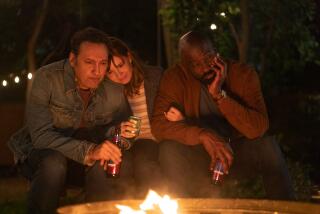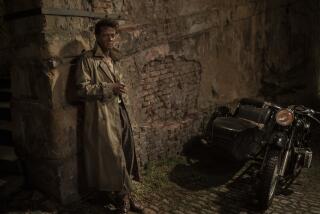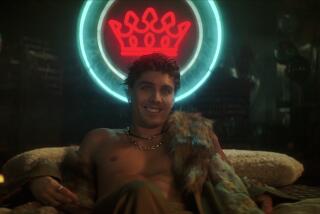‘Pet Sematary’ spoilers: How could they kill [redacted]?! Reboot directors explain their ending and that twist
Before premiering the new “Pet Sematary” — 30 years after Stephen King’s bestselling horror novel about a family’s disturbing dealings with death first hit the big screen — producer Lorenzo di Bonaventura issued a warning. “We shot three endings: dark, darker and darkest,” he told an audience in Los Angeles. “We chose darkest.”
As audiences this weekend discovered, the filmmakers also made a major change to King’s famous tale of death, loss and grief. In a spoiler-filled chat with The Times, directors Dennis Widmyer and Kevin Kölsch (“Starry Eyes”) explained themselves: What’s the meaning of “Pet Sematary’s” ending — and that huge new twist?!
(Beware: Beyond the pet sematary the ground is sour, and spoilers follow.)
Paramount’s R-rated reboot of the iconic King tome follows the Creed family — dad Louis (Jason Clarke), mom Rachel (Amy Seimetz), 8-year-old daughter Ellie (Jeté Laurence) and 2-year-old Gage (played by twins Hugo and Lucas Lavoie) — as they move from the city to small town Maine for a quieter life.
That promise of peace is cut short when a series of fateful events send the family into a tailspin of grief.
First, the family cat Church meets an untimely end thanks to a neighboring highway populated by speeding semi trucks. Kindly neighbor Jud Crandall (John Lithgow), leads Louis to an ancient burial ground beyond the “pet sematary” where local kids bury their beloved pets and supernatural forces can bring back the dead.
When Louis revives Church, the kitty comes back mean. When the Creeds lose one of their children in a tragic accident, Louis does the unthinkable — with much more terrible, no good results.
[Ellie] is the one who has the self-awareness to know what is happening to her — and she has the vocabulary to ask questions about it.
— Kevin Kölsch
The wrong kid died?
In the novel — and Mary Lambert’s 1989 film adaptation — it’s toddler Gage who’s killed by a careening Orinoco truck, then brought back from the dead with a serious malevolent streak by his grieving father. But Widmyer, Kölsch and screenwriter Jeff Buhler (working from a screen story by Matt Greenberg) made a bold change to the story and its consequences.
Instead of Gage, they killed Ellie, who has begun asking her parents about death and is hit by a speeding truck on her ninth birthday.
“The reason was that the older kid who was asking the questions about what happens when we die and what happens to our pets, that kid is the one who has the self-awareness to know what is happening to her — and she has the vocabulary to ask questions about it,” said Kölsch.
Louis has moved the family to Maine with a promise of less work and more quality time. But he ignores his family’s complaints about their new home, and then keeps the truth about Church secret. “And it doesn’t get better, it gets worse,” said Kölsch. “The only way they can be together as a family is in this … new way.”
Because mom Rachel has never processed her own sister Zelda’s death, and has buried the guilt of it her whole life, she deflects Ellie’s queries about death and the nearby pet cemetery. “Being put off by the openness of death is what also leads to this whole chain reaction, with disastrous consequences,” said Widmyer.
Eight-year-old Ellie, however, can continue those conversations after crossing the barrier. “The questions she was asking earlier in the movie, she can now explore from the other side of the veil,” said Kölsch. “We loved the psychology that opened up for us.”
Rather than an adorable-if-murderous baby wielding a scalpel and terrorizing his adult family — as seen in the 1989 adaptation with actor Miko Hughes as Gage — ballet-dancing Ellie has the ability to subject her parents and Jud, not to mention the audience, to more advanced terrors.
Of course, Di Bonaventura notes, they gave King an early heads-up on the big twist. “We wanted to see if he had any objections, and he was more than cool with it,” said the producer. “In some ways it’s true to the book because in the book the conversations about death are with Ellie. In that respect we’re following the book.”
“Ellie has now come back and she has the mind to be able to understand that she’s dead, that she died on the road that day,” said Widmyer. “She can talk about death and almost psychologically torture Louis with those questions. ‘Does Mommy know about me? What are you going to tell her?’ Those sort of needling questions that really get under your skin. Those are the moments we kind of live for.”
Widmyer points to the Gage of King’s book and his uncanny knowledge of things he shouldn’t know, particularly when it comes to Jud’s late wife, Norma. In the new film, Ellie uses the memory of Norma against Jud by conjuring the woman’s visage and similarly uses Rachel’s deeply repressed guilt over the childhood death of her own sister against her.
“That was important to us to bring into the movie, to psychologically kill a person before you physically kill them,” said Widmyer. “That’s why she says, ‘You wanted your sister to die. You prayed she would,’ and makes Amy confess to her darkest sins. That’s almost worse than stabbing her.”
Widmyer and Kölsch likewise use their audience’s memory of Lambert’s 1989 film against them to build anticipatory frights. When the camera peeks under a bed as Ellie is stalking Jud, it’s a cheeky misdirection reminiscent of the famous Achilles-slicing scene in the original “Pet Sematary.”
Teeing up the big truck set piece, the expectation that Gage is going to die as he does in the book and earlier film makes the weight of what happens land even more heavily, punctuated by heart-rending performances by Clarke and Seimetz that unfold not with a piercing scream but composer Christopher Young’s score playing.
They credit Laurence, who turned 11 during the shoot, with a preternatural talent for slipping effortlessly into her character’s sinister side. “She was a natural,” said Kölsch. “I don’t know necessarily where it came from!”
“Before we would do certain takes in certain scenes where she was evil Ellie she’d say, ‘Hey guys, could I just have a minute?’ And she’d go stand off by herself, look down and think for a minute, then she’d go: ‘OK. I’m ready.’ And she’d come back and she’d be evil Ellie. And she was so convincing.”
About those ‘dark’ multiple endings
Of course, once you turn Ellie into the primary antagonist, a chain reaction of subtle changes alters the path of the film. Evil Ellie explores different dynamics with the adults in her life, forcing everyone into a reckoning with their choices.
Instead of Louis making the awful decisions to bring back his dead family members — just as he stubbornly refuses to hear Rachel’s and Ellie’s unhappiness with their new home — it’s Ellie who sends her mother to the Pet Sematary and then revives her. Rachel in turn kills Louis before he can set his actions right.
Locked in the car for his own safety at film’s end, Gage’s fate seems pretty much sealed as his loving undead family comes for him ... although King himself volunteered his idea for a slightly cheerier alternate ending to EW.
The filmmakers confirm that they filmed an alternate ending — the original scripted ending — that will be included in the eventual home video/digital release.
Exactly what happens in that version the directors wouldn’t spill. But the alternate is “just as dark, if not darker” than the theatrical ending, teased Widmyer with a laugh. “There are no happy endings in this movie.”
You get to leave the theater not exactly sure how you feel, which is always more interesting to me. Whenever you [can] do that, it’s a victory for the genre.
— Dennis Widmyer
In both endings, Louis Creed is served with the terrible consequences of his desperation to keep his family together at all costs, says Kölsch: “It was a different sequence of events that was also dark that was arriving at the same, or somewhat similar conclusion of the arc. It was just about finding the one we thought worked better to serve the theme.”
“We call it wrapping it up in a black ribbon,” said Widmyer. “It is wrapped up, but not how you think it’s going to be.”
Well, who expects a happy ending from a Stephen King story?
“There are so many movies, even horror movies, that end in happy endings [where] somebody beats the bad guy,” said Widmyer. “Films like ‘Hereditary’ or ‘Rosemary’s Baby’ have these dark endings — ‘Rosemary’s Baby’ is a good example because it’s a dark ending, but she’s kind of happy that she has her kid. You get to leave the theater not exactly sure how you feel, which is always more interesting to me. Whenever you’re able to do that, it’s a victory for the genre.”
Making changes from the book
Nods and references to the book and 1989 film make their way into “Pet Sematary,” from the ankle-slicing to the Maine coons cast to play Church because of their resemblance to the cat on the front of King’s book. The Ramones’ famous tune “Pet Sematary,” recorded for the first film thanks to Lambert’s friendship with Dee Dee Ramone, is covered by Starcrawler and plays over the end credits. But a few key departures were made from previous iterations.
Gone is the specific reference to the Micmac tribe King wrote into his novel as Jud’s explanation of the place’s origins, a more culturally sensitive choice Widmyer and Kölsch made. Instead, it’s explained that indigenous people also encountered the grounds but fled after discovering its power.
The film also does not specify the illness that befell Rachel’s late sister. “It’s Rachel’s memory, but we never say what she has,” said Widmyer.
“It’s not only about modern sensitivities, but we thought it was interesting if this is one of those places where something supernatural happens that can’t be explained,” said Kölsch. “You think of all these places, like the Mystery Spot, Stonehenge and Easter Island — it’s the way we think about a lot of stories or religions, that these are people’s ways of explaining phenomena.”
“Or coping,” added Widmyer.
Another detail absent from the new film in the interest of keeping its plot streamlined was the bad blood between Rachel’s parents and Louis.
“There’s a small remnant of it where you can see the father-in-law give [Louis] the dirtiest look at the funeral, and that’s a tip of the hat to the subject matter,” said Di Bonaventura. “That’s one thing I would have loved to put in the movie, but we didn’t really have room for it.”
The future(s) of ‘Pet Sematary’
“The whole point of the Pet Sematary is, ‘Here’s a better option,’” joked Kölsch. Widmyer chimed in: “The barrier was not made to be broken.”
But could there be more trips to the burial grounds in the future?
Di Bonaventura, who also produced the “Transformers” movies and its recent spinoff, “Bumblebee,” admits he’s thought about it.
“I had no thinking of making a sequel to ‘Pet Sematary’ — for me, the only thing that I see is a prequel because we have so much of the book, there’s so much source material that is there that we can draw on,” he said. “If I was looking somewhere, I’m looking there.”
“The Wendigo is an interesting story that could be expanded on,”’ he continued. “I think there’s a lot of interesting material that still sits in that book.”
More to Read
Only good movies
Get the Indie Focus newsletter, Mark Olsen's weekly guide to the world of cinema.
You may occasionally receive promotional content from the Los Angeles Times.











